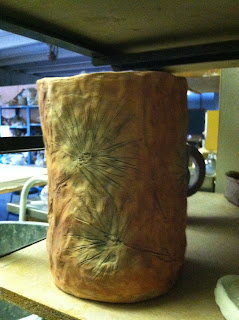I was going to add to the previous blog entry to expand upon "the gesture drawing" but instead I thought I would just give the topic its own space.
Our gesture drawings are timed. We have a live model. The teacher has a timer. 20 seconds or 30 seconds are about the length of the poses. The model changes to a new position when the timer goes off. I use vine charcoal on newsprint. We do this for about a half hour, then we start doing longer poses.
Some of my drawings have the length of time, written on them, but they all should. A gesture drawing is a loose capturing of the moment of the figure. Details are omitted, as there is not the time.
No outline is allowed- one has to sort of scribble out a person onto the paper really fast.
Our gesture drawings are timed. We have a live model. The teacher has a timer. 20 seconds or 30 seconds are about the length of the poses. The model changes to a new position when the timer goes off. I use vine charcoal on newsprint. We do this for about a half hour, then we start doing longer poses.
Some of my drawings have the length of time, written on them, but they all should. A gesture drawing is a loose capturing of the moment of the figure. Details are omitted, as there is not the time.
No outline is allowed- one has to sort of scribble out a person onto the paper really fast.
I am not impressed with the ones directly below- too stiff
These are a little nicer- more movement is apparent. these are probably 30 seconds.
This might have been a ten second:
I like these below, but a little too outliney!
This one, in my estimation is a good one.
five minute--is below












































